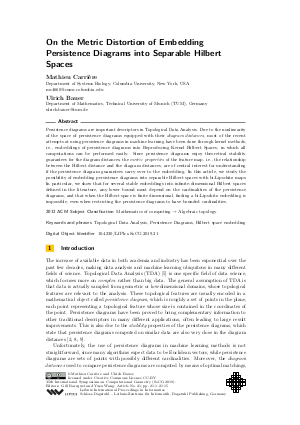On the Metric Distortion of Embedding Persistence Diagrams into Separable Hilbert Spaces
Authors Mathieu Carrière, Ulrich Bauer
-
Part of:
Volume:
35th International Symposium on Computational Geometry (SoCG 2019)
Part of: Series: Leibniz International Proceedings in Informatics (LIPIcs)
Part of: Conference: Symposium on Computational Geometry (SoCG) - License:
 Creative Commons Attribution 3.0 Unported license
Creative Commons Attribution 3.0 Unported license
- Publication Date: 2019-06-11
File

PDF
LIPIcs.SoCG.2019.21.pdf
- Filesize: 0.63 MB
- 15 pages
Document Identifiers
Subject Classification
ACM Subject Classification
- Mathematics of computing → Algebraic topology
Keywords
- Topological Data Analysis
- Persistence Diagrams
- Hilbert space embedding
Metrics
- Access Statistics
-
Total Accesses (updated on a weekly basis)
0Document
0Metadata
Abstract
Persistence diagrams are important descriptors in Topological Data Analysis. Due to the nonlinearity of the space of persistence diagrams equipped with their diagram distances, most of the recent attempts at using persistence diagrams in machine learning have been done through kernel methods, i.e., embeddings of persistence diagrams into Reproducing Kernel Hilbert Spaces, in which all computations can be performed easily. Since persistence diagrams enjoy theoretical stability guarantees for the diagram distances, the metric properties of the feature map, i.e., the relationship between the Hilbert distance and the diagram distances, are of central interest for understanding if the persistence diagram guarantees carry over to the embedding. In this article, we study the possibility of embedding persistence diagrams into separable Hilbert spaces with bi-Lipschitz maps. In particular, we show that for several stable embeddings into infinite-dimensional Hilbert spaces defined in the literature, any lower bound must depend on the cardinalities of the persistence diagrams, and that when the Hilbert space is finite dimensional, finding a bi-Lipschitz embedding is impossible, even when restricting the persistence diagrams to have bounded cardinalities.
Cite As Get BibTex
Mathieu Carrière and Ulrich Bauer. On the Metric Distortion of Embedding Persistence Diagrams into Separable Hilbert Spaces. In 35th International Symposium on Computational Geometry (SoCG 2019). Leibniz International Proceedings in Informatics (LIPIcs), Volume 129, pp. 21:1-21:15, Schloss Dagstuhl – Leibniz-Zentrum für Informatik (2019)
https://doi.org/10.4230/LIPIcs.SoCG.2019.21
BibTex
@InProceedings{carriere_et_al:LIPIcs.SoCG.2019.21,
author = {Carri\`{e}re, Mathieu and Bauer, Ulrich},
title = {{On the Metric Distortion of Embedding Persistence Diagrams into Separable Hilbert Spaces}},
booktitle = {35th International Symposium on Computational Geometry (SoCG 2019)},
pages = {21:1--21:15},
series = {Leibniz International Proceedings in Informatics (LIPIcs)},
ISBN = {978-3-95977-104-7},
ISSN = {1868-8969},
year = {2019},
volume = {129},
editor = {Barequet, Gill and Wang, Yusu},
publisher = {Schloss Dagstuhl -- Leibniz-Zentrum f{\"u}r Informatik},
address = {Dagstuhl, Germany},
URL = {https://drops.dagstuhl.de/entities/document/10.4230/LIPIcs.SoCG.2019.21},
URN = {urn:nbn:de:0030-drops-104259},
doi = {10.4230/LIPIcs.SoCG.2019.21},
annote = {Keywords: Topological Data Analysis, Persistence Diagrams, Hilbert space embedding}
}
Author Details
References
-
Henry Adams, Tegan Emerson, Michael Kirby, Rachel Neville, Chris Peterson, Patrick Shipman, Sofya Chepushtanova, Eric Hanson, Francis Motta, and Lori Ziegelmeier. Persistence Images: A Stable Vector Representation of Persistent Homology. Journal of Machine Learning Research, 18(8):1-35, 2017.

-
Ulrich Bauer and Michael Lesnick. Induced matchings and the algebraic stability of persistence barcodes. Journal of Computational Geometry, 6(2):162-191, 2015.

-
Christian Berg, Jens Christensen, and Paul Ressel. Harmonic Analysis on Semigroups: Theory of Positive Definite and Related Functions. Springer, 1984.

-
Peter Bubenik. Statistical Topological Data Analysis using Persistence Landscapes. Journal of Machine Learning Research, 16:77-102, 2015.

-
Gunnar Carlsson. Topology and Data. Bulletin of the American Mathematical Society, 46:255-308, 2009.

-
Mathieu Carrière, Marco Cuturi, and Steve Oudot. Sliced Wasserstein Kernel for Persistence Diagrams. In Proceedings of the 34th International Conference on Machine Learning, 2017.

-
Mathieu Carrière, Steve Oudot, and Maks Ovsjanikov. Stable Topological Signatures for Points on 3D Shapes. Computer Graphics Forum, 34, 2015.

-
Frédéric Chazal, Vin de Silva, Marc Glisse, and Steve Oudot. The Structure and Stability of Persistence Modules. Springer, 2016.

-
David Cohen-Steiner, Herbert Edelsbrunner, and John Harer. Stability of Persistence Diagrams. Discrete and Computational Geometry, 37(1):103-120, 2007.

-
Barbara Di Fabio and Massimo Ferri. Comparing Persistence Diagrams Through Complex Vectors. In Image Analysis and Processing - ICIAP 2015, pages 294-305, 2015.

-
Herbert Edelsbrunner and John Harer. Computational Topology: an introduction. AMS Bookstore, 2010.

-
Juha Heinonen. Lectures on Analysis on Metric Spaces. Springer, 2001.

-
Christoph Hofer, Roland Kwitt, Marc Niethammer, and Andreas Uhl. Deep Learning with Topological Signatures. In Advances in Neural Information Processing Systems 30, pages 1633-1643. Curran Associates, Inc., 2017.

-
Sara Kališnik. Tropical Coordinates on the Space of Persistence Barcodes. Foundations of Computational Mathematics, 2018.

-
Michael Kerber, Dmitriy Morozov, and Arnur Nigmetov. Geometry Helps to Compare Persistence Diagrams. Journal of Experimental Algorithmics, 22:1.4:1-1.4:20, September 2017.

-
Genki Kusano, Kenji Fukumizu, and Yasuaki Hiraoka. Persistence Weighted Gaussian Kernel for Topological Data Analysis. In Proceedings of the 33rd International Conference on Machine Learning, pages 2004-2013, 2016.

-
Genki Kusano, Kenji Fukumizu, and Yasuaki Hiraoka. Kernel Method for Persistence Diagrams via Kernel Embedding and Weight Factor. Journal of Machine Learning Research, 18(189):1-41, 2018.

-
Yuriy Mileyko, Sayan Mukherjee, and John Harer. Probability measures on the space of persistence diagrams. Inverse Problems, 27(12):124007, 2011.

-
Steve Oudot. Persistence Theory: From Quiver Representations to Data Analysis. Number 209 in Mathematical Surveys and Monographs. American Mathematical Society, 2015.

- Jan Reininghaus, Stefan Huber, Ulrich Bauer, and Roland Kwitt. A Stable Multi-Scale Kernel for Topological Machine Learning. CoRR, abs/1412.6821, 2014. URL: http://arxiv.org/abs/1412.6821.
-
Jan Reininghaus, Stefan Huber, Ulrich Bauer, and Roland Kwitt. A Stable Multi-Scale Kernel for Topological Machine Learning. In IEEE Conference on Computer Vision and Pattern Recognition, 2015.

-
James C. Robinson. Dimensions, Embeddings, and Attractors, volume 186 of Cambridge Tracts in Mathematics. Cambridge University Press, 2010.

-
Katharine Turner, Yuriy Mileyko, Sayan Mukherjee, and John Harer. Fréchet Means for Distributions of Persistence Diagrams. Discrete and Computational Geometry, 52(1):44-70, 2014.

